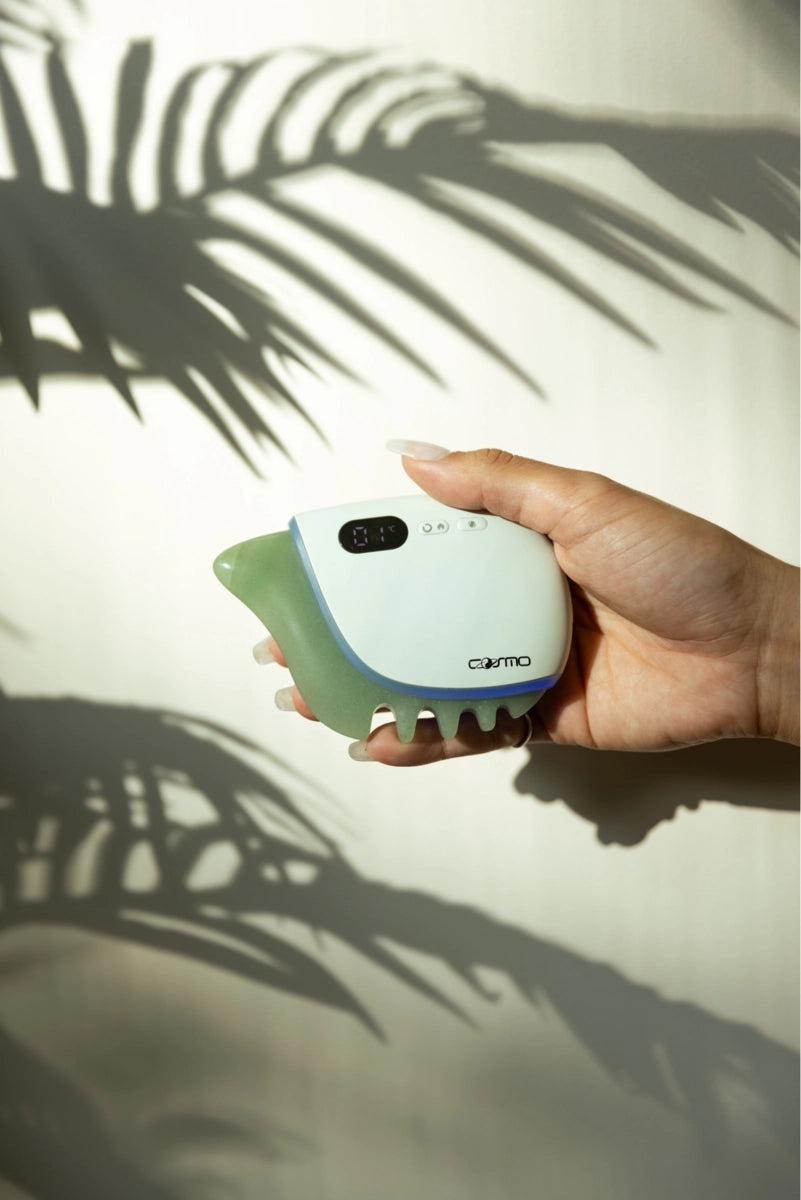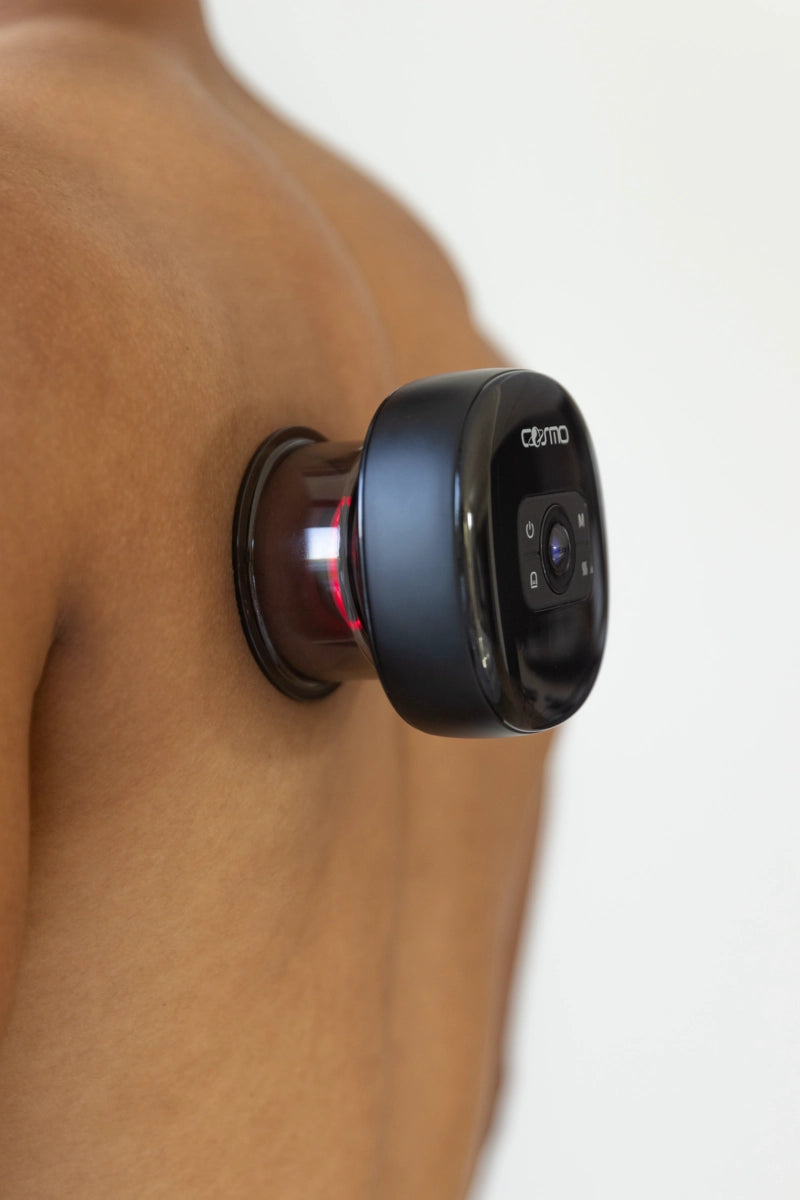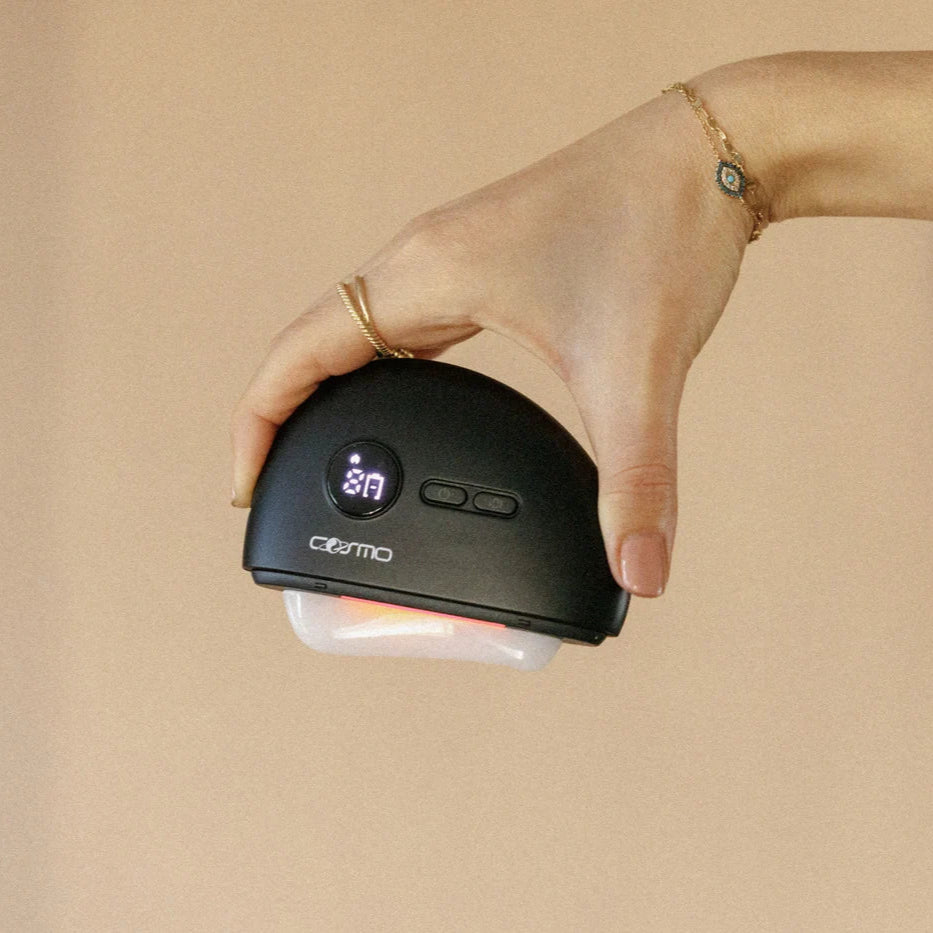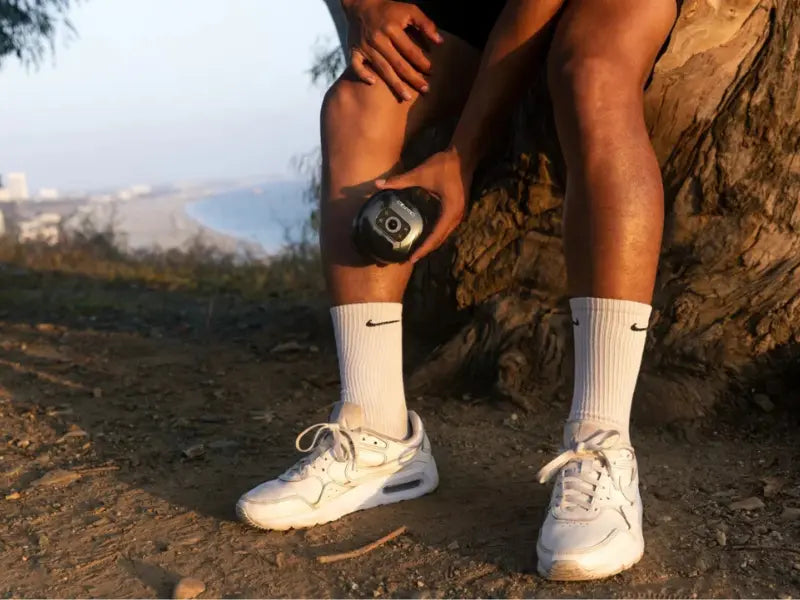If you’re struggling with persistent jaw tension or tightness in your face, you’re not alone. Modern stress has led to a surge in teeth grinding and jaw clenching, which contribute to temporomandibular joint (TMJ) pain. In fact, a 2021 survey by the
American Dental Association found over 70% of dentists reporting an increase in patients with stress-related clenching and grinding. Many are seeking new ways to find TMJ relief beyond mouthguards and pain meds. One increasingly popular approach is Gua Sha – an age-old therapy now touted as a natural remedy for jaw clenching and TMJ issues.
Gua Sha (pronounced gwah-shah) is an ancient technique from Traditional Chinese Medicine that involves gently scraping the skin with a smooth stone tool. Lately, this practice has exploded on social media and wellness blogs as a solution for facial tension and jaw pain. Search terms like gua sha jaw tension and gua sha TMJ relief are trending, reflecting growing curiosity about this method for easing tight jaw muscles. In this article, we’ll explore what Gua Sha is, how it can help with jaw tightness, and how to safely use it at home for jaw pain relief. Read on to learn the science-backed benefits and techniques for using Gua Sha as a home remedy to relax your jaw and find comfort.
Understanding Jaw Tension and TMJ Disorder
Jaw tension often goes hand in hand with TMJ disorder – a condition affecting the temporomandibular joints that connect your lower jaw to your skull. These joints and surrounding muscles enable you to chew, speak, and yawn. When they become overworked or misaligned, it can result in pain around the jaw, temples, or ears, difficulty opening and closing the mouth, clicking or popping sounds, and even headaches. TMJ disorder (sometimes called TMD) is quite common, affecting millions of people worldwide. Common causes include chronic stress (leading to unconscious clenching or grinding of teeth, known as bruxism), poor posture, past injuries, and arthritis in the jaw joint. Over time, this constant strain can inflame the TMJ and surrounding muscles, leading to persistent discomfort.
Traditional
treatments for TMJ-related jaw pain range from using nighttime bite guards to prevent grinding, to physical therapy exercises, pain relievers, muscle relaxants, or even surgery in severe cases. Many people also find some relief through practices like yoga, meditation, or gentle jaw relaxation massage to loosen up tight facial muscles. In recent years, there’s been a rising interest in alternative therapies for jaw tension. In one review, up to 62% of individuals with TMJ disorder have tried complementary treatments (such as acupuncture, facial massage, or Gua Sha) to manage their symptoms. This openness to holistic remedies has paved the way for Gua Sha’s resurgence as a tool for jaw and TMJ care.
What Is Gua Sha?
Gua Sha is a facial massage technique rooted in East Asian medicine, and its name roughly means “scraping” to remove stagnation. Traditionally, practitioners use a small, flat tool with smooth edges (often made of jade, quartz, or metal) to press and stroke the skin in one direction. The goal is to boost circulation and relieve areas of tension or blockage. Gua Sha has been used for centuries on the body to treat various ailments – from muscle pain and inflammation to fever – by scraping the skin to stimulate healing. When applied to the face and jaw, however, Gua Sha is done more gently. The tool (sometimes called a jade scraper or Gua Sha stone) is glided along the skin with light pressure, usually after applying facial oil to prevent pulling. This gentle scraping motion increases blood flow to the area and can help drain lymphatic fluid.
Think of Gua Sha as a type of tool-assisted massage for your face. It’s essentially a manual jaw massager when used along the jawline – helping to stretch and relax tight muscles. Fans of facial Gua Sha also rave about its beauty benefits. By reducing puffiness and boosting circulation, it may give your skin a temporary glow and a firmer appearance. Many use jawline gua sha not only to ease tension but also to define their jaw contours. While cosmetic perks are a bonus, our focus here is on relief: using Gua Sha to reduce that clenched, aching feeling in the jaw.
Importantly, Gua Sha is a simple, low-risk practice when done correctly. It does not require any electrical device or medication – just a quality gua sha tool and some know-how. This makes it appealing for those seeking a gua sha benefits without invasive treatments. Before we dive into how to do it, let’s look at why Gua Sha might actually help alleviate tension from a scientific perspective.
How Gua Sha Helps Relieve Jaw Tension
At first glance, gently scraping a stone along your skin might sound too simple to impact deep muscle tension. However, there are several physiological reasons why Gua Sha can provide relief for tight jaw muscles and TMJ pain. The action of stroking the skin with a Gua Sha tool increases surface circulation to the area. By boosting blood flow, you’re bringing in more oxygen and nutrients to tight muscles and carrying away metabolic wastes. This can help knotted muscle fibers in the jaw relax and recover. In fact, Gua Sha’s scraping motion is known to promote natural remedy for jaw clenching effects by easing built-up tension in the fascia (connective tissue) and muscles.
Moreover, the technique encourages lymphatic drainage. Many of us hold excess fluid or mild swelling in the face (especially after clenching or nighttime grinding). By guiding this fluid away (for example, down the neck), Gua Sha reduces puffiness and pressure that contribute to soreness. The overall effect is akin to a deep tissue massage, just targeted with a small tool. According to health experts, using a Gua Sha tool to stroke the skin can promote detoxification, relax tight muscles, and encourage healing in the treated area. This means Gua Sha may help reduce inflammation around the TMJ and calm overactive muscles like the masseter (the main jaw muscle that bulges when you clench your teeth).
Gua Sha might also trigger a beneficial immune response. The gentle “scraping” causes very mild, temporary petechiae (tiny red dots or speckles under the skin) as small blood vessels are stimulated – this is normal and actually part of how Gua Sha works. The body responds by sending immune-modulating and anti-inflammatory molecules to the area, which can accelerate healing. Gua sha technique for jaw muscles essentially signals your body to repair and relieve the stressed tissue. As circulation improves and inflammation goes down, people often feel their tight jaw start to loosen up. They might notice less pain while chewing or fewer headaches stemming from tension.
Another key aspect is the neurological effect: Gua Sha provides a novel sensory input (the feeling of gentle scraping) that can help disrupt pain signals. It also encourages you to consciously relax your jaw during the treatment, retraining those habitually clenched muscles to let go. All of these factors combined make Gua Sha a promising tool for jaw and TMJ issues. But what evidence do we have that it really works? Let’s explore some benefits of gua sha for tmj that researchers and users have observed.
Benefits of Gua Sha for TMJ Relief
While formal research on Gua Sha specifically for TMJ is still emerging, early findings and plenty of anecdotal reports suggest it can be effective. People who regularly perform Gua Sha on their jaw often report less pain, improved jaw mobility, and even relief from related symptoms like tension headaches or neck pain. In one small clinical study, patients with TMJ disorder received
Gua Sha therapy twice a week for four weeks. By the end of the trial, they showed significant improvements in pain, jaw function, and quality of life compared to their baseline. In simpler terms, these individuals could open their mouths more easily and experienced less daily discomfort after incorporating Gua Sha into their routine.
Another related study looked at
Gua Sha for chronic neck pain (which often accompanies TMJ issues due to muscle tension spreading to the neck). It found that Gua Sha treatments led to noticeable pain reduction and better range of motion in the neck, outperforming a control group that received no treatment. Since neck and jaw tension are frequently connected, this lends support to Gua Sha’s usefulness in a TMJ care regimen.
Beyond the studies, there’s a growing community of patients and holistic practitioners vouching for Gua Sha’s jaw benefits. Many dentists and physical therapists acknowledge that gentle manual techniques – like massage or Gua Sha – can complement standard TMJ treatments. These methods improve blood circulation and muscle flexibility, tackling the root causes of pain rather than just masking symptoms. Gua Sha, in particular, offers a do-it-yourself approach to daily management of jaw tension. It’s a self-care tool you can use whenever your jaw feels tight or after a long day of clenching, to get some immediate relief.
The gua sha jaw tension approach also appeals to those who prefer natural, drug-free solutions. Unlike taking a painkiller (which might temporarily dull the pain but won’t fix underlying tightness) or just ignoring the problem, doing a quick Gua Sha massage gives you an active role in your healing. Over time, regularly performing Gua Sha may even help break the cycle of clenching by training your jaw to stay more relaxed. Users often find that it reduces the frequency of TMJ flare-ups and can shorten the duration of jaw pain episodes. And as a bonus, you might notice cosmetic benefits like a sharper jawline or healthier complexion due to the increased circulation – truly a win-win scenario.
Of course, it’s important to keep realistic expectations: Gua Sha isn’t a magic cure-all for severe TMJ disorders. If you have structural issues in the jaw joint or severe misalignment, you’ll still need guidance from a dentist or specialist. But for muscular tension and mild to moderate TMJ discomfort, Gua Sha can be a potent aid. The best part is, you can easily try it at home. Up next, we’ll outline an easy jaw relaxation massage routine using Gua Sha that you can incorporate into your daily schedule for relief.
How to Perform Gua Sha for Jaw Tension (Step-by-Step)
One of the great things about Gua Sha is that it’s simple enough to do on your own once you learn the basic technique. All you need is an appropriate tool and a few minutes. Here is a step-by-step gua sha technique for jaw muscles that targets tension in the jaw, cheek, and neck areas:
-
Prepare Your Skin: Start with a clean face and jaw. Apply a few drops of facial oil or a moisturizer along your jawline, cheeks, and neck. Lubrication is key – it allows the gua sha tool to glide smoothly and prevents any skin irritation. You can use any face oil you like (jojoba, almond, etc.). This also begins the relaxation process for your muscles.
-
Position the Tool: Take your Gua Sha stone (make sure it’s clean). For the jaw area, you’ll want to use one of the notched or curved sides of the tool. Hold it at a roughly 30 to 45-degree angle to your skin (almost flat against the skin, not poking straight in). A common starting point is the center of your chin.
-
Scrape Along the Jawline: Gently but firmly drag the tool from your chin towards the angle of your jaw (the point below your ear). Follow the contour of your jawbone. Use smooth, even strokes with light to medium pressure. It should feel pleasant – never painful. You can wiggle the tool a little at the end of the stroke near the ear to massage that tight spot. Repeat this stroke 5–10 times on one side of the jaw, then switch to the other side. This action helps release the tense masseter muscle that runs along the jawline.
-
Massage the Cheek and TMJ Area: Next, place the tool just above the jawline – by the corner of your mouth – and stroke upward along the cheek toward the ear. This targets the masseter’s upper fibers and the TMJ region. Again, do several gentle strokes. You might open and close your mouth a few times here to feel the muscle movement and identify sore spots. Spend a bit of extra time gently pressing or scrubbing tiny circles right at the TMJ (directly in front of your ear), as this can be a trigger point for pain.
-
Work the Neck: The neck is an important, often overlooked area in jaw tension relief. By clearing tension and lymph in the neck, you help the jaw relax. Use a sweeping stroke down the side of your neck. Start just below the ear (where you ended the jaw stroke) and glide the tool downward toward your collarbone. Use very light pressure on the neck and keep it comfortable. Do a few strokes down each side of the neck. This encourages lymphatic drainage – flushing out any built-up fluid and reducing pressure in the jaw and face.
-
Repeat and Finish: You can repeat these sequences (jawline, cheek, neck) one or two more times as needed. Take slow, deep breaths as you do the strokes – this helps engage your parasympathetic nervous system (the “rest and relax” mode). If you find a particularly tight spot (for example, a knot in the jaw muscle), you can hold the tool there with mild pressure for a few seconds to help it release. When finished, gently stretch your jaw by opening your mouth slowly or doing a few mock yawn movements. You should feel warmth and relaxation in the area. Pat off any excess oil and clean your Gua Sha tool with mild soap and water.
This simple routine can be done once a day, perhaps at night to release the day’s tension or in the morning to alleviate any overnight clenching stiffness. It usually takes about 5-10 minutes. Always listen to your body – Gua Sha should feel soothing. Adjust pressure if you experience pain. Over time, you’ll likely get more in tune with your facial anatomy and can adjust the strokes to what feels best for you.
Tips and Precautions for Safe Gua Sha
Gua Sha is generally very safe, but there are a few tips and precautions to ensure you get the most benefit without any issues:
-
Be Gentle and Go Slow: Especially on the face, a lighter touch is effective. Unlike traditional body Gua Sha which can leave red marks, facial Gua Sha for jaw tension should not be so intense that you bruise heavily. A little bit of redness or pink flush is normal due to increased circulation, but you’re not trying to cause pain. If you press too hard, you risk soreness or capillary damage. Remember, facial massage techniques work with consistency and care, not brute force.
-
Use a Good Tool: Opt for a tool made of smooth material (jade, rose quartz, or stainless steel are common). It should have a comfortable shape that can contour to your jaw and face. A quality gua sha kit may include multiple shapes for different areas. Always inspect the tool for any rough edges that could scratch skin. Keep it clean to avoid introducing bacteria – wash it after each use.
-
Relax Your Muscles: Try not to actively clench or resist while doing Gua Sha. Keep your jaw slack (you can even keep your mouth slightly open with your tongue resting in the bottom of your mouth). This allows the tool to really get into the muscle. Also, ensure you’re in a comfortable seated position, maybe in front of a mirror, so you’re not straining your neck or shoulders as you work on your jaw.
-
Stay Consistent but Don’t Overdo It: Like any therapy, regular practice yields the best results. Doing your Gua Sha jaw routine a few times a week consistently is more beneficial than one very long, intense session once in a blue moon. That said, give your skin time to recover if needed. If you notice any significant tenderness, take a day off. Most people tolerate daily facial Gua Sha well, but everyone’s sensitivity differs.
-
Watch for Side Effects: Mild redness is expected, and occasionally you might get petechiae (tiny red dots) or slight bruising, especially if you are prone to bruising. Don’t be alarmed – these marks are usually painless and fade within a few days. In fact, in Gua Sha therapy these light bruises (sha) are considered part of the healing response. However, if you experience sharp pain, significant swelling, or broken skin, stop and give yourself time to heal. Always avoid any active pimples, cuts, or irritated skin on the face as scraping over these can worsen them.
-
Consult if in Doubt: If you have a serious TMJ disorder, severe pain, or an underlying health condition (such as a bleeding disorder, or you’re on blood thinners), check with a healthcare provider before starting Gua Sha. Also, consider seeking out a professional demonstration. Many acupuncturists and massage therapists are trained in Gua Sha. A quick session with a professional can teach you proper techniques tailored to your needs. They can also pinpoint specific pressure points for your case. While DIY Gua Sha is effective, a professional’s insight is invaluable if you have persistent issues.
By following these tips, you can ensure your Gua Sha practice is safe and enjoyable. The goal is to gradually melt away the tension – you should feel better after the session, not tenderized! When done right, Gua Sha will leave your jaw area feeling looser and “lighter” due to the improved circulation and muscle release.
Choosing the Right Gua Sha Tool for Jaw Relief
When it comes to performing Gua Sha on yourself, the tool you use does matter. The good news is that Gua Sha tools are widely available and generally affordable. Classic tools are made of semi-precious stones like jade or rose quartz. Jade has been traditionally favored in Chinese medicine for its cooling properties and balancing energy. A simple jade or stone Gua Sha tool often looks like a flat, rounded jade scraper with various curved edges to fit different parts of the face. For beginners, a basic smooth-edged stone is a great start. It’s durable and easy to handle. You might even consider a complete gua sha kit that comes with the tool and perhaps a facial oil or an instruction card – a convenient way to ensure you have everything needed for at-home practice.
In recent years, modern innovations have taken Gua Sha to the next level. There are now advanced at-home gua sha device options that combine traditional scraping with new technology. For example, Cosmo’s LunaStone series of Gua Sha tools integrates features like gentle vibration, heat therapy, and LED light with a jade scraping surface. The addition of heat can further relax muscles and increase circulation, while vibration aids in deeper tissue stimulation. Buy gua sha tools that have these enhancements if you’re looking for a spa-level treatment at home. A device like the LunaStone Ultra even offers red and blue light therapy along with adjustable warmth and vibration settings. According to a Cosmo press release, the vibration in such a device can boost circulation and aid lymphatic drainage, intensifying
Gua Sha’s benefits for pain relief and relaxation. In other words, these gadgets aim to amplify the effects of a manual Gua Sha massage, potentially giving you faster or more pronounced relief from jaw tension.
Whether you choose a high-tech tool or a simple stone, a few factors remain important. The tool should feel comfortable in your hand and on your face. Look for one with a thinner edge (not sharp, but tapered) to really get into the contours of your jaw. A thicker or very blunt edge might not provide the same pressure precision. If you tend to have sensitive skin, stone type can matter: jade and quartz stones are generally skin-friendly, whereas some metals might irritate. Always use a tool on clean skin with a lubricant, as mentioned, to prevent any dragging.
Lastly, keep your tool clean and charged (if it’s an electronic device). Wipe it down after each use with a soft cloth and mild soap if needed. For electronic ones, follow the manufacturer’s care instructions (usually avoid submerging in water, etc.). A well-chosen and maintained tool will be your ally in long-term jaw care. Over time, you may even accumulate a few favorites – perhaps a basic jade tool for travel and a more advanced jaw massager device for nightly routines. The exact tool is less important than using it correctly and consistently, but having one you love to use will encourage you to stick with your Gua Sha habit.
Embrace Gua Sha for a Tension-Free Jaw
Chronic jaw tension and TMJ pain can really impact your day-to-day life, but they don’t have to be a life sentence. Embracing Gua Sha as a self-care ritual offers a practical path to relief. It’s empowering to have a technique at your fingertips that can melt away tightness in minutes. After all, our jaw does so much – talking, chewing, expressing emotions – so it deserves a little TLC! Gua Sha provides just that: a moment of mindful massage that not only eases soreness but also feels inherently relaxing. Many users report better sleep and reduced stress when they make facial Gua Sha part of their routine, because it encourages overall relaxation.
As we’ve discussed, the beauty of Gua Sha is in its simplicity and effectiveness. You don’t need to be a professional to do it, and you don’t need to invest a lot of time. With a consistent practice, you may find that you wake up with less stiffness, your jaw moves more smoothly, and those tension headaches or ear aches become less frequent. In addition, you’re likely to see some skin benefits – consider it a bonus glow while you treat your aches. All of this comes from a holistic method that’s been around for ages, which speaks to its staying power. Modern science is catching up, with early evidence backing the benefits people have felt anecdotally for years.
If you’re curious to experience these benefits firsthand, all you need to do is give it a try. Grab a Gua Sha stone or device, follow the steps for a jaw relaxation massage, and see how you feel. Always remember to be gentle and patient with yourself; improvements may be subtle at first but tend to build with time. And of course, integrate Gua Sha alongside other healthy habits for TMJ: jaw stretches, stress management (to reduce clenching triggers), and regular dental check-ups if grinding is an issue. Gua Sha is one piece of the puzzle in achieving a relaxed, pain-free jaw.
Finally, if you’re ready to invest in your self-care toolkit, you can buy gua sha tools from trusted wellness brands like Cosmo. Cosmo’s line of Gua Sha products, for example, is designed with this blend of tradition and innovation in mind, ensuring you get both authenticity and effectiveness. But regardless of the brand or type of tool, the key takeaway is that relief is within reach. With Gua Sha, a calmer, happier jaw could be just a few soothing strokes away.
Sources:
Citations
All Sources















